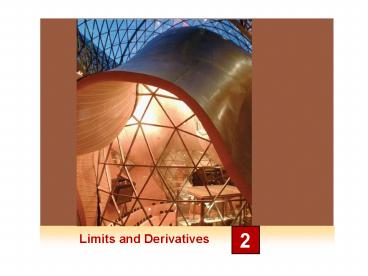Limits and Derivatives - PowerPoint PPT Presentation
1 / 22
Title: Limits and Derivatives
1
Limits and Derivatives
2
2
The Limit of a Function
2.2
3
The Limit of a Function
- To find the tangent to a curve or the velocity of
an object, we now turn our attention to limits in
general and numerical and graphical methods for
computing them. - Lets investigate the behavior of the function f
defined by - f (x) x2 x 2 for values of x near 2.
4
The Limit of a Function
- The following table gives values of f (x) for
values of x close to 2 but not equal to 2.
5
The Limit of a Function
- From the table and the graph of f (a parabola)
shown in Figure 1 we see that when x is close to
2 (on either side of 2), f (x) is close to 4.
Figure 1
6
The Limit of a Function
- In fact, it appears that we can make the values
of f (x) as close as we like to 4 by taking x
sufficiently close to 2. - We express this by saying the limit of the
function - f (x) x2 x 2 as x approaches 2 is equal to
4. - The notation for this is
7
The Limit of a Function
- In general, we use the following notation.
- This says that the values of f (x) tend to get
closer and closer to the number L as x gets
closer and closer to the number a (from either
side of a) but x ? a.
8
The Limit of a Function
- An alternative notation for
- is f (x) ? L as x ? a
- which is usually read f (x) approaches L as x
approaches a. - Notice the phrase but x ? a in the definition
of limit. This means that in finding the limit of
f (x) as x approaches a, we never consider x a. - In fact, f (x) need not even be defined when x
a. The only thing that matters is how f is
defined near a.
9
The Limit of a Function
- Figure 2 shows the graphs of three functions.
Note that in part (c), f (a) is not defined and
in part (b), f (a) ? L. - But in each case, regardless of what happens at
a, it is true that limx?a f (x) L.
Figure 2
in all three cases
10
Example 1 Guessing a Limit from Numerical Values
- Guess the value of
- Solution
- Notice that the function f (x) (x 1)?(x2 1)
is not defined when x 1, but that doesnt
matter because the definition of limx?a f (x)
says that we consider values of x that are close
to a but not equal to a.
11
Example 1 Solution
contd
- The tables below give values of f (x) (correct to
six decimal places) for values of x that approach
1 - (but are not equal to 1).
- On the basis of the values in the tables, we make
- the guess that
12
The Limit of a Function
- Example 1 is illustrated by the graph of f in
Figure 3. - Now lets change f slightly by giving it the
value 2 when - x 1 and calling the resulting function g
Figure 3
13
The Limit of a Function
- This new function g still has the same limit as
- x approaches 1. (See Figure 4.)
Figure 4
14
One-Sided Limits
15
One-Sided Limits
- The Heaviside function H is defined by
-
. - H(t) approaches 0 as t approaches 0 from the left
and H(t) approaches 1 as t approaches 0 from the
right. - We indicate this situation symbolically by
writing - and
16
One-Sided Limits
- The symbol t ? 0 indicates that we consider
only values of t that are less than 0. - Likewise, t ? 0 indicates that we consider
only values of t - that are greater than 0.
17
One-Sided Limits
- Notice that Definition 2 differs from Definition
1 only in that we require x to be less than a.
18
One-Sided Limits
- Similarly, if we require that x be greater than
a, we get the right-hand limit of f (x) as x
approaches a is equal to L and we write - Thus the symbol x ? a means that we consider
only x gt a. These definitions are
illustrated in Figure 9.
Figure 9
19
One-Sided Limits
- By comparing Definition 1 with the definitions of
one-sided limits, we see that the following is
true.
20
Example 7 One-Sided Limits from a Graph
- The graph of a function g is shown in Figure 10.
Use it to state the values (if they exist) of the
following
Figure 10
21
Example 7 Solution
- From the graph we see that the values of g(x)
approach 3 as x approaches 2 from the left, but
they approach 1 as x approaches
2 from the right. - Therefore
- and
- (c) Since the left and right limits are
different, we conclude from (3) that limx?2
g(x) does not exist.
22
Example 7 Solution
contd
- The graph also shows that
- and
- (f) This time the left and right limits are the
same and so, - by (3), we have
- Despite this fact, notice that g(5) ? 2.

